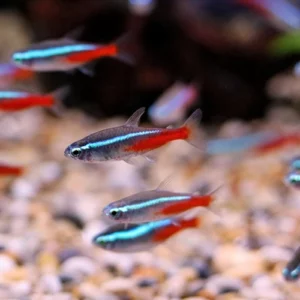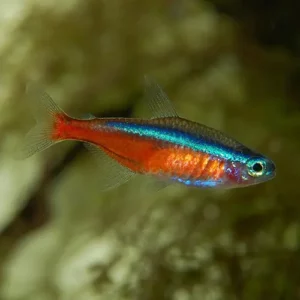Can Neon Tetra Live With Shrimp? Yes And How
Neon Tetras and Freshwater Shrimp can live harmoniously in an aquarium due to their complementary behaviors. Neon Tetras are known for their peaceful schooling nature, while Freshwater Shrimp are adept scavengers. Their compatibility is bolstered by distinct feeding zones, diet overlaps, and the tetras’ non-aggressive temperament. However, challenges like potential predation on shrimp fry and different water sensitivities need careful management. A thriving shared environment requires a spacious tank, ample hiding spots, stable water parameters, and specific acclimation techniques. A balanced and varied diet, alongside avoiding overfeeding, ensures both species’ health and well-being.
Home » Guides » Fish Care » Neon Tetra » Can Neon Tetra Live With Shrimp? Yes And How
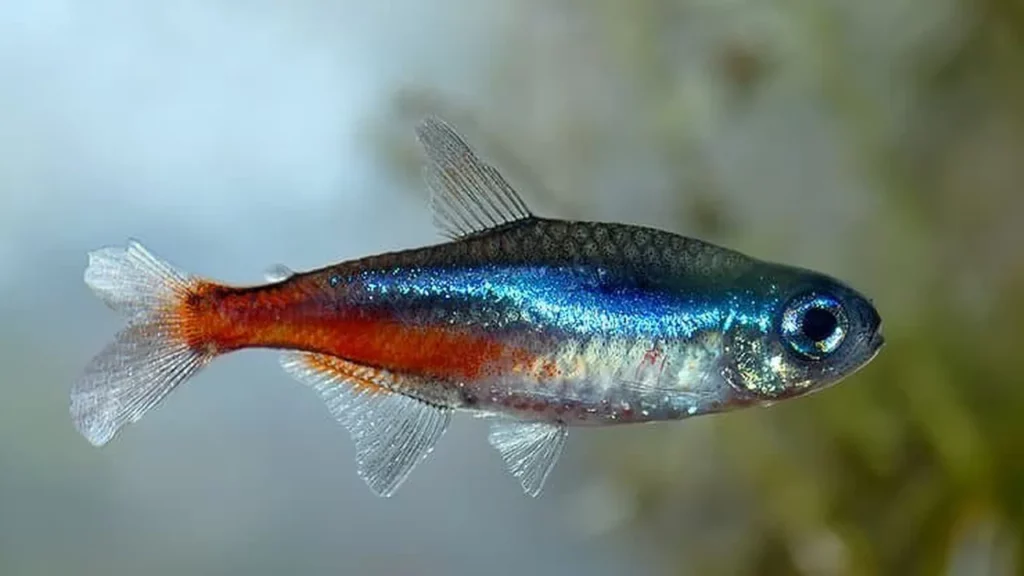
|
|
|
|
|
|
|
|
|
Neon Tetra Fact Sheet
| Scientific Name | Paracheirodon innesi |
| Common Name | Neon Tetra, Neons |
| Care Difficulty | Easy |
| Life Expectancy | 3-10 Years |
| Average Size | 1.5 Inches (3.8cm) |
| Temperature | 72°F – 82°F (22°C -28°C) |
| Diet | Omnivore |
| Behavior | Friendly/Peaceful |
| Breeding | Medium/Hard |
| pH | 6-7.5 |
| Live Plant Friendly | Yes |
Natural Behavior of Neon Tetra and Shrimp
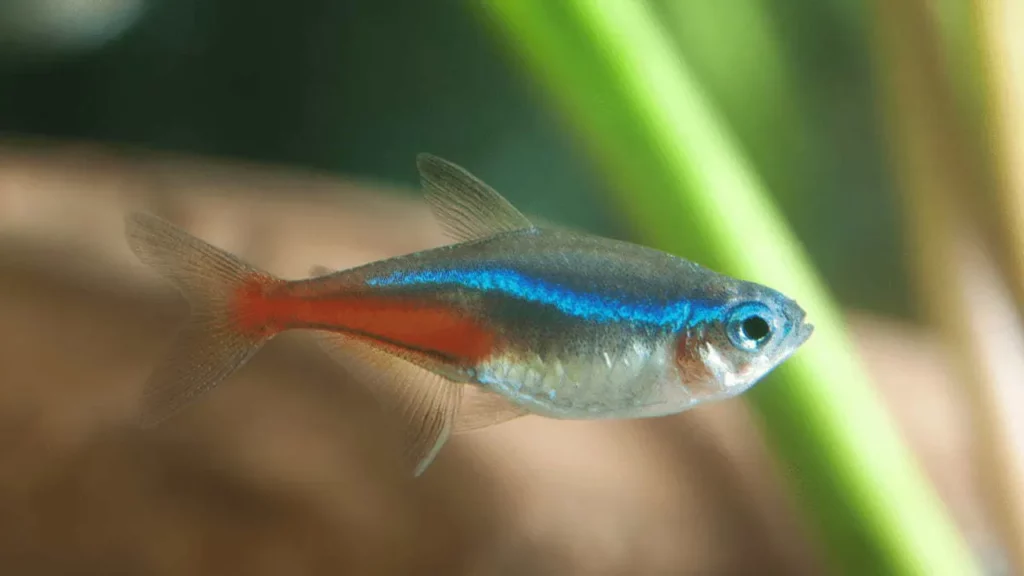
Neon Tetras
Peaceful Schooling Nature: At the heart of their charming demeanor lies a peaceful temperament. Neon Tetras are true social butterflies of the aquatic world. They flourish in groups, typically known as “schools.” And it’s not just for the aesthetics; their schooling nature is a survival instinct. By swimming in groups, they create a mesmerizing, shimmering display which confuses potential predators. A lone Neon Tetra, on the other hand, might feel stressed, and in the wild, can be easy pickings.
Dietary Habits: “What’s on the menu for these little lights?” you might wonder. Well, Neon Tetras are omnivorous by nature. Their diet primarily consists of small invertebrates and plant matter in the wild. In captivity, they readily accept high-quality flake food, but always appreciate the occasional treat of live or frozen brine shrimp, daphnia, or bloodworms. Keeping their diet varied not only ensures they get all the essential nutrients but also adds a little spice to their life! After all, variety is the very essence of life, isn’t it?
Freshwater Shrimp
Scavenging Behavior: Freshwater shrimp are nature’s efficient little cleaners. They diligently sift through the substrate, scuttling about in search of decaying plant matter, algae, and any tidbit of food they can find. Observing them in action is a delight. They’re like the detectives of the aquatic world, always on the lookout for the next clue… or in their case, food particle.
Molting Periods: Now, this is where things get truly fascinating. Shrimp undergo a process called molting, where they shed their exoskeleton to grow. Think of it as outgrowing a pair of shoes and needing a new pair! Before molting, they’ll often hide, preparing for this vulnerable period. After the molt, it’s quite interesting to spot the ghostly white, discarded exoskeleton. But don’t be alarmed; it’s a sign of growth and, given time, the shrimp will harden its new shell and be on its merry way.
Vulnerability: Speaking of molting, it’s during this period that our shrimp friends are most vulnerable. Without their toughened exterior, they can become a target for even the most peaceful of fish. Hence, during these times, they prefer to keep a low profile, hiding amidst dense vegetation or tucking themselves into nooks and crannies. It’s their way of saying, “Please, a little privacy!”
Factors Supporting Compatibility
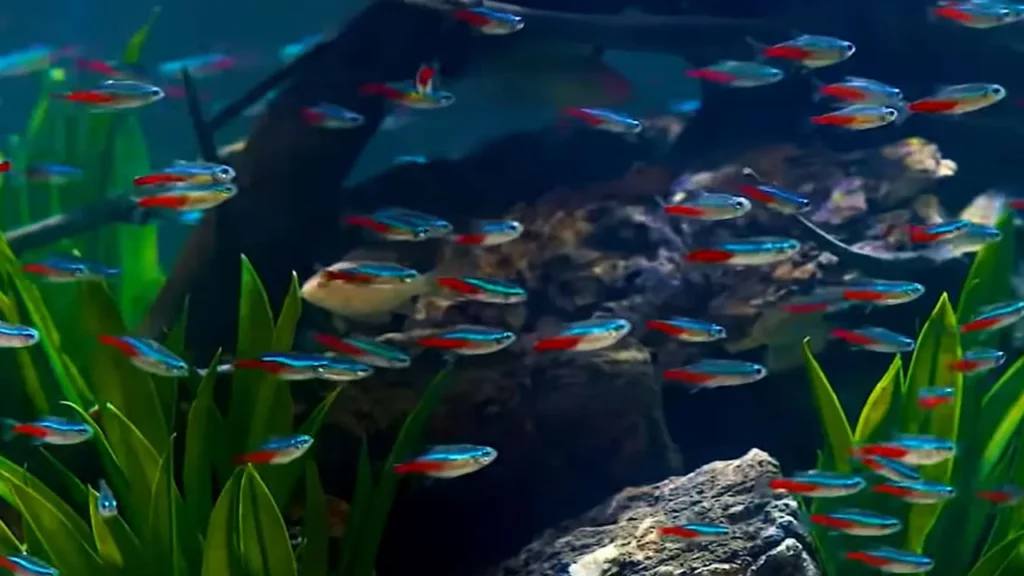
Diet Overlaps
Neon Tetras, with their omnivorous appetite, enjoy a wide-ranging menu, from flake foods to the occasional treat of small invertebrates. They primarily feed in the mid-water column, gracefully darting around, catching floating food particles in their path.
Our shrimp comrades, on the other hand, are bottom feeders. Their scavenging habits lead them to explore the tank’s substrate, hunting for decaying plant matter, algae, and any food remnants that might have settled from above. It’s like they have an unwritten pact with the Neon Tetras: “You take the mid, and we’ve got the bottom covered.”
This distinction in feeding habits and zones dramatically reduces competition for food. The fact that they aren’t vying for the same morsels at the same time means there’s less likelihood of conflict. They essentially have different dining tables in the same grand restaurant!
And so, diet-wise, these two species harmonize well, each respecting the other’s dining preferences and space. It’s a beautiful aquatic ballet of give and take, showing us that even in the wild, mutual respect is the key to peaceful cohabitation.
Distinct Habitat Zones
Neon Tetras: As previously highlighted, these vibrant fish have a penchant for the mid-water column. They don’t often venture to the tank’s floor, nor do they habitually rise to the very top. This middle territory is where they feel most secure and comfortable, schooling together in a synchronized dance that’s a marvel to behold. It’s their zone of preference, a space where they can swim freely, find food, and avoid disturbances.
Freshwater Shrimp: The substrate of the aquarium is where these diligent critters come alive. They’re like nature’s little janitors, tirelessly scuttling about, scavenging for food particles, algae, and decaying matter. It’s also here, amongst the gravel, sand, and aquatic plants, that they find shelter and seclusion, especially during their molting periods.
By nature’s design, these two inhabitants have distinct habitat zones, minimizing the potential for territorial disputes. The Neon Tetras have the mid-section, while the shrimp claim the base. This separation not only aids in fostering a sense of security for both species but also offers aquarists a multi-layered visual spectacle, from the shimmering Neons above to the fascinating shrimp escapades below. It’s like watching two different shows on the same channel, each captivating in its own right!
Non-aggressive Temperament of Tetras
Neon Tetras, with their flashy colors, might give off an aura of flamboyance, but don’t be deceived; they’re one of the most peaceful fish you’ll find in the hobby. They don’t possess the aggressive tendencies associated with some other fish species.
Their primary focus? To swim, to school, and to engage in their delightful mid-water ballet. Predatory behaviors, especially towards creatures like the freshwater shrimp, are generally not in their repertoire.
But here’s an interesting observation: Despite their passive nature, Neon Tetras do exhibit a curious streak. They might occasionally check out a shrimp or two, especially if it’s new to the tank. But this is more out of curiosity than malice.
Shrimps, with their exoskeleton, aren’t an easy snack either. A fully grown shrimp might be approached, but it’s generally left alone after a quick inspection. Neon Tetras recognize that shrimps are neither food nor threat, so there’s no incentive for them to exhibit aggressive behaviors.
Challenges in Keeping Neon Tetras and Shrimp Together
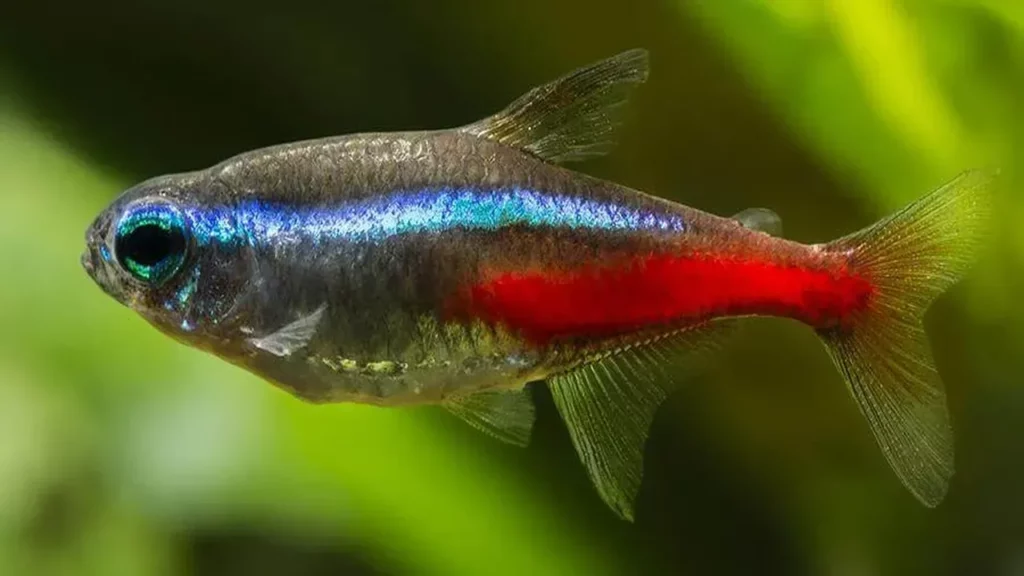
Neon Tetras vs. Shrimp Fry
Tiny and Tempting: Shrimp fry are minuscule, often barely visible to the naked eye in the initial stages after birth. Their tiny size and slow movements can make them tempting targets, even for otherwise peaceful fish like Neon Tetras. Remember, in the aquatic food chain, small, slow-moving creatures are often seen as prey by larger, faster swimmers.
Neon Tetra’s Opportunistic Nature: While adult shrimp don’t particularly entice our Neon friends, the shrimp fry can be a different story. Neon Tetras, being opportunistic feeders, might snatch up shrimp fry if they come across them. It’s not a matter of malice; it’s just instinct. If it fits in their mouth and it moves, there’s a possibility it’ll be seen as food.
Natural Survival Instinct: On the flip side, shrimp fry have evolved with survival instincts of their own. They tend to stay hidden in dense vegetation, moss, or crevices during their early days, venturing out only when they’ve grown enough to not be an easy snack.
Shrimp Vulnerability During Molting
The Molting Process: At various stages of their growth, shrimp will shed their exoskeleton – a protective outer shell. Think of it as outgrowing an old coat. This shedding process is nature’s way of allowing the shrimp to grow and sport a new, better-fitting shell. Sounds simple enough, right? However, immediately after shedding the old exoskeleton, the shrimp’s new shell is soft and pliable, leaving them defenseless until it hardens.
The Window of Vulnerability: This post-molt phase is when the shrimp are most exposed. Without their rigid shell, they’re soft, fragile, and can be more easily harmed. Even the usually peaceful Neon Tetras might get curious and nip at these soft-shelled shrimp. Again, it’s not out of a desire to bully, but more out of curiosity and the opportunistic nature of fish.
Nature’s Defense Mechanism: Understanding their vulnerability, shrimp often take precautionary measures. During molting periods, they tend to become reclusive, hiding among dense plants, tucking into crevices, or burrowing under substrate. It’s their way of saying, “Time for a brief hiatus until I’m back in top form.”
Different Water Parameter Sensitivities
Shrimp and Their Delicate Nature: Freshwater shrimp, for all their hardworking demeanor, are sensitive souls when it comes to water conditions. They thrive in stable environments and can be particularly finicky about sudden changes in water parameters. Be it pH, temperature, hardness, or the levels of nitrate and ammonia, consistency is the key. Even slight fluctuations can stress shrimp, affecting their health, molting process, and breeding capabilities.
Neon Tetras’ Relative Flexibility: Neon Tetras, on the other hand, are a tad more forgiving. Originating from the Amazonian waters, they’re used to some level of fluctuation. However, this doesn’t mean they’re entirely undemanding. They still require clean, well-maintained water to flourish. But, compared to shrimp, they might tolerate minor inconsistencies a bit better.
Striking a Balance: The challenge, then, is to find a middle ground – a water parameter range that caters to the needs of both inhabitants. Regular water testing becomes essential to ensure parameters stay within the desired range. Regular, small water changes, rather than infrequent large ones, can help maintain stability and avoid shocking either species.
Setting up a Compatible Environment
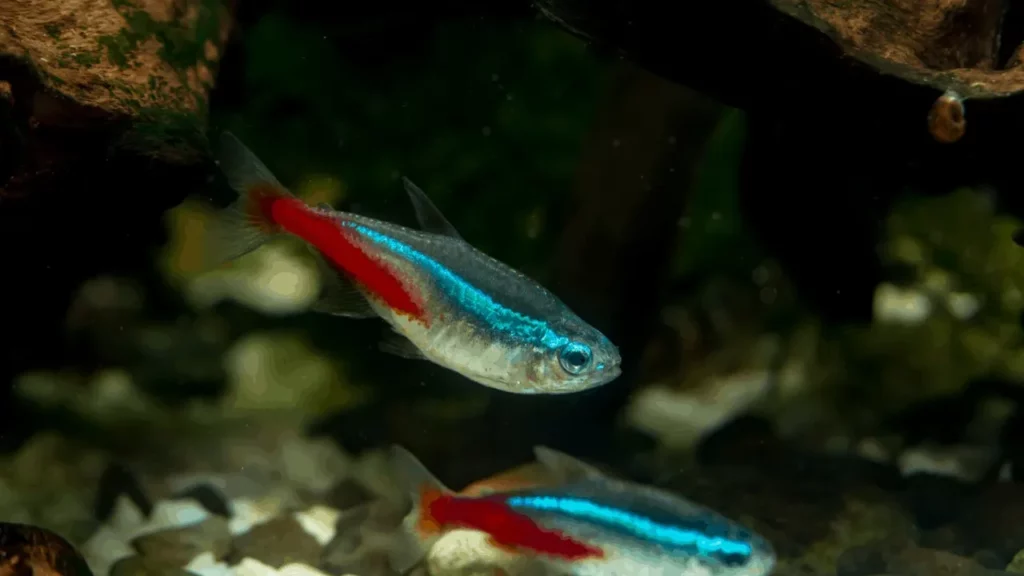
Sufficient Tank Size
Neon Tetras – Social Swimmers: These little luminous wonders are not just picturesque; they’re social beings. They prefer to school, which means a group of them together, darting and dancing in synchronized grace. For such aquatic choreography, space is essential. While a small group can manage in a 10-gallon tank, for a more vibrant, active school and to truly let them exhibit natural behaviors, a tank starting from 20 gallons or larger is recommended.
Freshwater Shrimp – Ground Explorers: While they might not cover as much distance as our Neons, shrimps love to roam the substrate, scavenging, foraging, and occasionally climbing plants and decorations. Their territorial needs might be less compared to the Tetras, but they still appreciate some elbow (or should I say antenna?) room.
The Combined Need: When housing both these species, the general guideline is “bigger is better.” Starting with at least a 20-gallon tank ensures that the Neon Tetras have ample room to school in the middle and upper sections, while the shrimp can go about their scavenging activities without feeling cramped at the bottom.
A spacious environment reduces stress, decreases competition for resources, and offers aquarists the opportunity for more intricate aquascaping – creating a more enriched, naturalistic environment. After all, just as we humans cherish a spacious living room or a backyard, our aquatic pals too thrive when given room to explore, grow, and be themselves. An ample tank is the foundation upon which a thriving aquatic community is built.
Plenty of Hiding Spots for Shrimp
Nature’s Camouflage Artists: Shrimp, with their knack for blending in, are masters of camouflage. This isn’t just a fancy party trick but a survival mechanism honed through evolution. Dense vegetation, intricate pieces of driftwood, and caves or crevices serve as their sanctuaries, especially during those aforementioned vulnerable molting periods.
Aquascaping with Purpose: While we may think of plants, rocks, and driftwood as decorative elements, for shrimp, these are crucial aspects of their habitat. Java moss, for instance, not only adds a lush green touch to your aquarium but provides an intricate network of leaves and stems for shrimp to nestle in. Similarly, strategically placed caves or overhangs offer the shrimp a secluded spot to retreat to when they feel threatened or just need a break from the hustle and bustle.
Benefits Beyond Shelter: These hiding spots aren’t just for hiding; they’re multifunctional! Dense plant cover acts as a buffet, where shrimp can graze on microscopic algae and biofilm. Driftwood and certain types of rocks can also harbor tiny organisms, providing a source of natural nutrition.
Furthermore, hiding spots reduce stress. Imagine living in an open field with nowhere to retreat. Sounds daunting, right? For shrimp, a well-scaped tank with ample hiding spots ensures that they always have a safe corner to retreat to, promoting healthier, more active, and longer-living shrimp.
Stable Water Parameters
Consistency Over Perfection: Many aquarists, especially newcomers, might chase “perfect” water parameters. However, it’s not always about hitting the bullseye on a specific pH or hardness level. More often than not, consistency trumps perfection. Sudden swings in water conditions can be far more stressful for aquarium inhabitants than a parameter that’s slightly off from the “ideal” but remains stable.
Sensitive Shrimp: Freshwater shrimp, as we’ve touched upon before, can be especially sensitive to changes in their environment. Rapid shifts in pH, temperature, or water hardness can lead to stress, hampered molting processes, and in extreme cases, even fatalities. Their preference for stability makes it essential to monitor water conditions regularly, ensuring that any deviations are caught and corrected gently.
Neon Tetras’ Needs: While Neon Tetras might be a smidge more forgiving than their shrimp counterparts, they too thrive in consistent conditions. Originating from soft, slightly acidic waters of the Amazon, they prefer a pH range of 6.0-7.5 and temperatures between 70-81°F (21-27°C). Keeping these parameters stable is key to vibrant colors, active schooling behavior, and overall well-being.
Achieving Stability: The path to stable water conditions is paved with regularity. Regular water testing, consistent maintenance routines, and gradual changes (when needed) are the trifecta of stability. Investing in a reliable water testing kit and making small, frequent water changes (as opposed to larger, infrequent ones) can go a long way in maintaining a balanced aquatic environment.
Acclimation and Introduction Tips
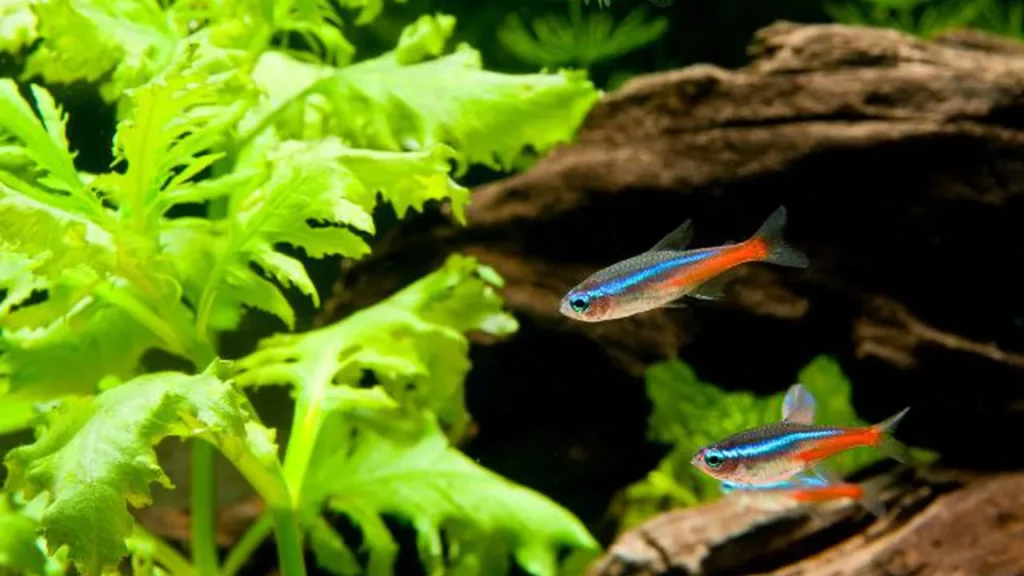
Quarantining New Inhabitants
The Need for Quarantine: Just as we humans sometimes carry germs without showing symptoms, so too can fish and shrimp. They might appear healthy but could be carriers of pathogens or parasites. By isolating newcomers, we’re giving ourselves a window to observe and ensure they’re not only healthy but also won’t introduce any unwanted guests to the main tank.
Setting up a Quarantine Tank: The ideal quarantine setup doesn’t need to replicate the grandeur of your main aquarium. A simple tank, equipped with basic filtration, heating (if necessary), and minimal decoration, suffices. The goal is observation and prevention, not necessarily aesthetics.
Duration & Observation: A quarantine period of 2-4 weeks is generally recommended. During this time, closely monitor the new arrivals for signs of stress, disease, or unusual behavior. Remember, patience is your ally. The assurance that your main tank remains disease-free is worth the wait.
Treatment, If Needed: If, during quarantine, you notice any signs of illness, this isolated environment allows for easier treatment without affecting the entire community in the main tank. Once the newcomers are deemed healthy and any treatments have been successfully concluded, they can be introduced to the main aquarium.
A Note on Empathy: Quarantine, though vital, can be a bit stressful for our aquatic friends. Ensure they have some hiding spots and are kept in a quiet location. Regular, small water changes can help maintain water quality, making the transition smoother for them.
Slow Introduction
Drip Acclimation – A Gentle Process: One of the most recommended methods for acclimating sensitive species, especially shrimp, is drip acclimation. Here’s how it works:
- Bag and Basin: After you’ve quarantined your aquatic pals, transfer them to a bag or container filled with their current water.
- Drip Setup: Using airline tubing, create a siphon from the main tank to the bag or container. By tying a knot in the tubing or using a clamp, you can control the water flow to a slow drip.
- Time and Patience: Let the water from the main tank slowly drip into the container. This gradual mixing allows the inhabitants to slowly adjust to the water parameters of the main tank. Depending on the sensitivity of the species and the difference in water parameters, this process can take anywhere from 30 minutes to a few hours.
- Final Introduction: Once acclimated, gently net the fish or shrimp out of the container (avoid pouring the container’s water into your main tank) and introduce them into their new home.
Why So Slow? Rapid changes in water parameters can lead to osmotic shock, particularly in sensitive species like many freshwater shrimp. Drip acclimation helps in avoiding such drastic changes, ensuring a smoother transition for the newcomers.
Observation Continues: After the introduction, closely watch the newly added inhabitants. Ensure they’re behaving normally and aren’t showing signs of stress or aggression from other tank mates. This period is essential as they get accustomed to their new surroundings and neighbors.
Monitoring Initial Interactions
The First Few Hours: These are crucial. As the new additions start exploring their surroundings, keep a vigilant eye on their behavior and the reactions of the existing inhabitants. Neon Tetras, with their gleaming colors, might be curious about the new territory they’re venturing into. At the same time, your shrimps, with their innate exploratory nature, could be scouting for hiding spots and food sources.
Signs of Aggression: While Neon Tetras are generally peaceful, individual personalities vary. Watch out for any nipping or chasing, especially towards the more vulnerable shrimp. If aggressive behavior persists, consider creating more hiding spots or, in extreme cases, temporarily isolating the aggressive individual to calm down.
Stress Indicators: Beyond aggression, stress is another key factor to monitor. Signs such as rapid breathing, erratic swimming, or excessive hiding can indicate that the new entrants are feeling overwhelmed. If these signs persist, it’s essential to assess the possible causes – be it water parameters, territorial disputes, or lack of sufficient hiding spots.
The Role of Feeding: To ease the transition, consider feeding the tank shortly after introducing the newcomers. A well-fed community is less likely to show aggression. Plus, the act of feeding can distract the inhabitants, making the introduction smoother.
An Ongoing Process: While the initial interactions are vital, remember that monitoring should be ongoing. Over the next few days, as hierarchies are established and territories marked, continue observing their dynamics. This ensures that any potential issues are nipped in the bud, creating a harmonious environment for all.
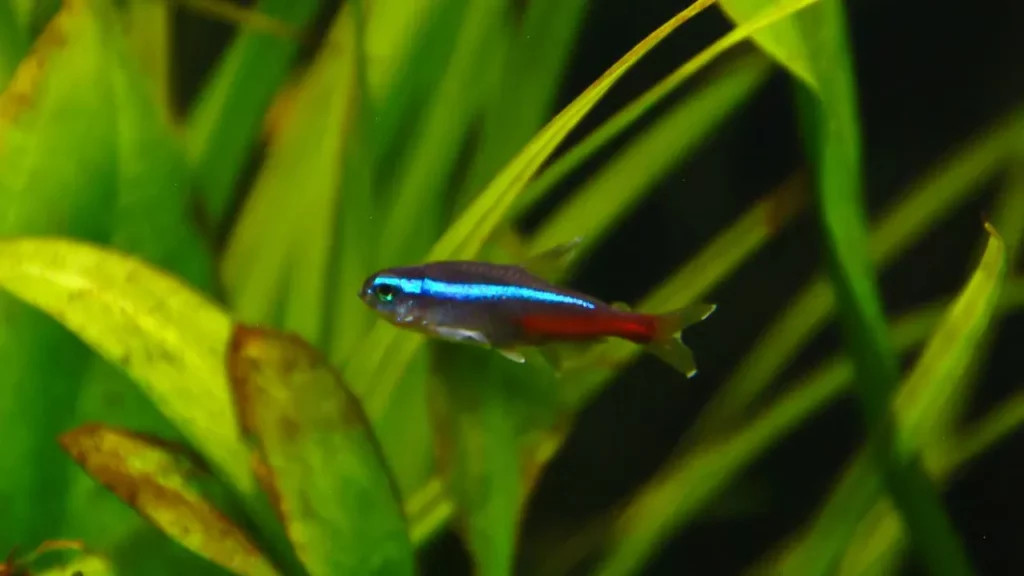
Feeding Zones
Neon Tetras – Mid-Water Munchers: The iridescent Neon Tetras, with their shimmering bodies and vivacious energy, usually prefer to dine in the mid-water column. When you sprinkle flake food or tiny pellets, you’ll often see them dash and dart, catching these morsels as they slowly descend.
Freshwater Shrimp – Bottom Buffet Goers: On the flip side, our diligent shrimp are like the cleanup crew at the banquet. They’re scavengers, foraging along the substrate, picking up uneaten food bits, and grazing on algae. Sinking pellets or specialized shrimp food often becomes their primary course.
Creating Zones: To establish distinct feeding zones:
- Floating Foods: For the Tetras, opt for foods that float momentarily before slowly sinking, giving them ample opportunity to grab their share.
- Targeted Feeding: For the shrimp, consider using a feeding dish or placing food directly at specific spots using feeding tongs. This not only ensures the shrimp get their food but also helps in reducing uneaten food accumulating in the substrate.
- Diverse Diet: Occasionally, mixing up the diet and introducing live or frozen foods like daphnia or brine shrimp can create exciting feeding frenzies, providing both nutrition and entertainment.
Benefits of Feeding Zones: Having designated zones reduces competition and aggression. It ensures that food is evenly distributed, and every inhabitant gets their nutritional needs met. Moreover, it aids in maintaining water quality, as it’s easier to manage and remove uneaten food from specific areas.
Diet Variety
For the Luminous Neon Tetras:
- Flakes and Micro Pellets: These are staples for most tetras. They’re formulated to provide a balanced diet and are easy for the tetras to consume in the mid-water column.
- Live or Frozen Foods: Introducing foods like brine shrimp, daphnia, or bloodworms can be a delightful treat for them. These foods are not only tasty but are also packed with proteins and essential nutrients.
- Vegetable Matter: Occasionally, you can offer them tiny bits of blanched vegetables like spinach or peas. They’re rich in vitamins and can aid in digestion.
For the Scavenging Shrimp:
- Sinking Pellets: These are specially designed for bottom feeders and provide the shrimp with essential nutrients.
- Vegetable Supplements: Shrimps often relish blanched zucchini, cucumbers, or spinach. These vegetables are rich in vital minerals and can boost their exoskeleton health.
- Algae Wafers: Shrimps have a natural inclination towards algae. Offering them algae wafers can help mimic their natural grazing behavior.
- Calcium Enriched Foods: Shrimp require calcium for a strong exoskeleton. Incorporate calcium-rich foods or supplements to support their molting process.
Offering the Best of Both Worlds: On occasion, you can introduce foods that both tetras and shrimp can enjoy. For instance, when you add live brine shrimp, the neon tetras will gleefully chase them in the mid-water, while the shrimps will scavenge for any that make it to the bottom.
Remember, while variety is essential, moderation is key. Every addition to their menu should be introduced gradually and in small quantities. Monitor their responses, and if any food remains uneaten, it’s a sign to adjust the portion sizes.
Avoiding Overfeeding
Just as we might sometimes go overboard with that extra slice of cake or an additional helping at dinner, it’s easy to mistakenly overfeed our aquatic pals. The consequences, however, can be quite profound in an enclosed ecosystem. Overfeeding can impact both the health of our underwater friends and the water quality of their habitat.
The Risks of Overfeeding:
- Degraded Water Quality: Excess food that isn’t consumed decays, leading to a spike in ammonia and nitrite levels. These can be harmful, if not deadly, especially to more sensitive species like shrimp.
- Unwanted Algal Blooms: The leftover nutrients from uneaten food can trigger algae growth, turning your pristine aquatic paradise into a murky green mess.
- Health Complications: Overfed fish can develop fatty liver disease and other health issues. Similarly, shrimps may struggle with molting if there’s an imbalance in their diet.
Strategies to Ensure Optimal Feeding:
- Observe and Adjust: Initially, watch how much food your inhabitants consume in about 2-3 minutes. If there’s leftover food after this time, you’re likely feeding them too much. Adjust the quantity accordingly in the subsequent feedings.
- Use a Feeding Schedule: Consistency can be your ally. Designate specific feeding times, and try to stick to them. For many tanks, feeding once or twice a day is sufficient.
- Consider a Feeding Ring: For floating foods, a feeding ring can contain the food in one area, preventing it from scattering and making it easier for fish like the Neon Tetras to feed.
- Vacation Precautions: If you’re away, consider using automatic feeders or instruct someone with clear guidelines. Often, well-meaning friends or family might overfeed, thinking they’re doing your pets a favor.
- Regular Tank Maintenance: Even with the best precautions, some food might escape your inhabitants’ attention. Regular cleaning and siphoning of the substrate can help remove these remnants, maintaining water quality.
Overfeeding is a common misstep, especially for novice aquarists. We often equate feeding with care – after all, who doesn’t want to ensure their beloved pets are well-fed? However, in the aquatic realm, restraint is a form of affection. By offering just the right amount, we’re paving the way for a cleaner, healthier, and happier environment for our finned and shelled friends. The key is to feed with intention, not just affection. And as you’ll discover, this balanced approach not only sustains their bodies but also nourishes the soul of your aquatic haven.
Frequently Asked Questions – FAQ
Give Us Feedback
Please help us get better by making suggestions or giving feedback, we really do listen to it!
